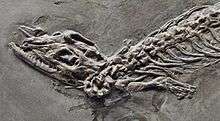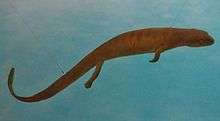Palaeopleurosaurus
| Palaeopleurosaurus | |
|---|---|
| Fossil specimen | |
| Scientific classification | |
| Kingdom: | Animalia |
| Phylum: | Chordata |
| Class: | Reptilia |
| Order: | Rhynchocephalia |
| Family: | †Pleurosauridae |
| Genus: | †Palaeopleurosaurus Carroll, 1985 |
| Species: | †P. posidoniae |
| Binomial name | |
| Palaeopleurosaurus posidoniae Carroll, 1985 | |
Palaeopleurosaurus is an extinct genus of diapsid reptiles belonging to the group Sphenodontia.[1]

Fossil

Model
Palaeoleurosaurus fossils were discovered in Bavaria, Germany from Toarcian (Early Jurassic) deposits,[2] dated to about 183 million years ago.[3] It is one of the few known aquatic sphenodontians,[1] a lifestyle supported by increased bone density in its gastralia.[4] However, the lack of increase in rib and femur bone density suggests that the lineage of Palaeopleurosaurus became gradually adapted to aquatic lifestyles. Histology shows that the number of growth rings in Palaeopleurosaurus was smaller than the living tuatara, possibly indicating a shorter lifespan.[4]
References
- 1 2 Dupret, V. (2004). The pleurosaurs: anatomy and phylogeny. Revue de Paléobiologie, 9: 61-80.
- ↑ R. L. Carroll, R. L. (1985). A pleurosaur from the Lower Jurassic and the taxonomic position of the Sphenodontida. Palaeontographica Abteilung A, 1985. Volume 189. Pages 1-28.
- ↑ Paleobiology Database. Retrieved 10 June 2012.
- 1 2 Klein, N.; Scheyer, T.M. (2017). "Microanatomy and life history in Palaeopleurosaurus (Rhynchocephalia: Pleurosauridae) from the Early Jurassic of Germany". The Science of Nature. 104 (4). doi:10.1007/s00114-016-1427-3.
This article is issued from
Wikipedia.
The text is licensed under Creative Commons - Attribution - Sharealike.
Additional terms may apply for the media files.